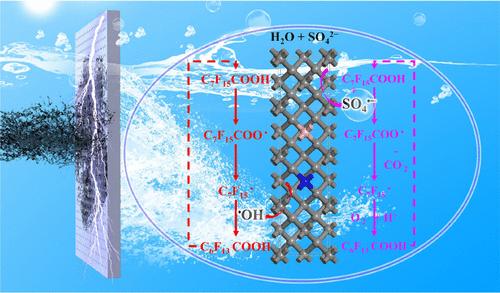促进硫酸盐溶液生成SO4·-和·OH在B/ n掺杂金刚石流动电极上对有机污染物的高效电化学氧化
IF 11.3
1区 环境科学与生态学
Q1 ENGINEERING, ENVIRONMENTAL
引用次数: 0
摘要
电化学氧化通过现场生成的活性氧(ROS)对难降解有机污染物的矿化是有效的。然而,活性氧的低产率和低利用效率往往限制了氧化性能。本文设计了一种增强SO4·- /·OH生成和利用的B/ n掺杂金刚石(BND)流动电极,用于硫酸盐溶液中有机污染物的电化学氧化。通过调节B/N掺杂,提高了SO4·- /·OH的产率和SO4·-选择性,并通过流动方式促进了SO4·- /·OH的生成和利用。在2.0 ~ 5.0 mA cm-2的低电流密度下,BND表现出PFOA的快速氧化,动力学常数为2.56 ~ 4.58 h-1。其氧化PFOA的能耗为2.15 ~ 6.46 kWh m-3,低于同类条件下的先进电极。BND阳极对含氟有机废水和焦化废水也有较好的处理效果。其优异的性能是由于其提高了SO4·- /·OH的产率和利用率,并具有较高的SO4·-选择性。本文章由计算机程序翻译,如有差异,请以英文原文为准。

Promoting SO4·– and ·OH Generation from Sulfate Solution toward Efficient Electrochemical Oxidation of Organic Contaminants at a B/N-Doped Diamond Flow-Through Electrode
Electrochemical oxidation via in situ-generated reactive oxygen species (ROS) is effective for the mineralization of refractory organic pollutants. However, the oxidation performance is usually limited by the low yield and utilization efficiency of ROS. Herein, a B/N-doped diamond (BND) flow-through electrode with enhanced SO4·–/·OH generation and utilization was designed for electrochemical oxidation of organic pollutants in sulfate solution. Both its SO4·–/·OH yields and SO4·– selectivity were improved by regulating B/N doping, and the production and utilization of SO4·–/·OH were facilitated by flow-through mode. BND showed fast PFOA oxidation with kinetic constants of 2.56–4.58 h–1 at low current densities of 2.0–5.0 mA cm–2. Its energy consumption for PFOA oxidation was 2.15–6.46 kWh m–3, which was lower than those of state-of-the-art electrodes under similar conditions. The BND anode was also efficient for treating organic fluorine wastewater and coking wastewater. The superior performance was contributed by its enhanced SO4·–/·OH yields and utilization, as well as high SO4·– selectivity.
求助全文
通过发布文献求助,成功后即可免费获取论文全文。
去求助
来源期刊

环境科学与技术
环境科学-工程:环境
CiteScore
17.50
自引率
9.60%
发文量
12359
审稿时长
2.8 months
期刊介绍:
Environmental Science & Technology (ES&T) is a co-sponsored academic and technical magazine by the Hubei Provincial Environmental Protection Bureau and the Hubei Provincial Academy of Environmental Sciences.
Environmental Science & Technology (ES&T) holds the status of Chinese core journals, scientific papers source journals of China, Chinese Science Citation Database source journals, and Chinese Academic Journal Comprehensive Evaluation Database source journals. This publication focuses on the academic field of environmental protection, featuring articles related to environmental protection and technical advancements.
 求助内容:
求助内容: 应助结果提醒方式:
应助结果提醒方式:


